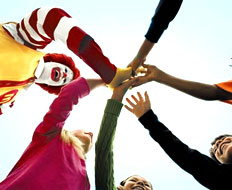As far back as I can remember in my McDonald’s career, Ray Kroc preached the importance of giving back to the community. He always said that if we were going to take money from the residents, we should be giving back value to the place where they lived and worked. He called it being “Mr. McDonald’s.” Make sure community members understand that if they need anything, they should think of McDonald’s first. Be it Little League uniforms, disaster relief, the local school, or police and fire benefits, they should come to us first. He also understood guilt. How could they eat somewhere else when their son was wearing a McDonald’s baseball uniform? And it worked.
As the years went on, specific programs began to develop. Markets and even stores began to have their own local-store marketing coordinators. These were folks who went out and found the causes that should be supported in the area and figured out ways to do so that were profitable to the stores, also. My favorite was “A Is for Cheeseburger.” What a genius idea. The grade-school kid brought his report card into the store and got a Be My Guest card, which gave one free cheeseburger for each A on the card. Parents loved us, schools idolized us. And we darn near went broke. Seems that some schools would give grades for attitude, attendance, neatness, and near anything else besides academics. A kid could get an A for not getting on the wrong school bus. But we sold a lot of french fries and shakes, and a parent had to bring the kid, so we sold lots of Big Macs, too.
Ronald McDonald got involved in the schools by putting on programs such as fire safety, stranger danger, the fun of reading, and the importance of good health, all without talking about McDonald’s in the program. Again, the schools loved us.
Eventually this all led to the Ronald McDonald House, probably one of the most successful cause programs ever. And it can all be traced back to actions as simple as some stores in Wisconsin throwing a handful of hard candy in the bottom of the sack because the farmers loved it.
Cause marketing is giving back to the community by usually giving a percentage of sales to causes in that immediate area. Sure, it can be national and even global, but locally is where it works best. It transcends charity because it directly involves the customer. And it definitely works. Let’s look at some numbers.
In a recent Edelman goodpurpose Consumer Survey, 20 percent of the respondents said they bought a specific product because there was a cause associated with that product. Eighty-three percent thought every company should have a cause associated with it. Sixty-one percent said they would try a new brand because it has a cause. And 83 percent said they would change their buying habits to a brand that was cause-related. So cause marketing will definitely improve sales and profit while it benefits the community.
To get started on your own cause-marketing program, you need to remember three very important facts. First, the cause must be relevant to the consumer. It doesn’t do any good to try to convince him to support a national day of straightening paper clips if he just doesn’t care about the plight of paper clips. You have to be able to support what he wants to help.
Second, your company must truly care about the causes you are supporting. You must talk about them, be visible with them, and work at it yourself. You can’t just give money and leave for Aruba.
And third, you must recognize the value of the program you are in and fully commit to it. Cause marketing is not a short-term proposition. You will significantly improve customer loyalty and sales, but it is for the long term. Most projects you will be involved with will take time. The local PTO will convince its members to eat with you because you are directly supporting their efforts to provide a computer lab for the school district. This does not mean donating one used Mac SE/30. And new athletic equipment does not mean two pairs of shoes and a lacrosse stick. You are in it for the long haul, and you should be.
How do you get going? There are companies that do this sort of thing for the quick-serve industry. It can all be as simple as signing up and determining what percentage of sales you can give. The customer simply goes to a website, registers, and selects the local cause he wants to support. Then you give him a receipt when he buys, he goes back on the website, enters his receipt number, and the company sends the money to the cause. One thing you must do is market the fact that you are doing this. Get out to the service clubs, schools, the Humane Society, anyone with a large number of members, and tell them about your new service for the community. You have to blow your own horn—in a nice way, of course. I find this to be particularly successful with schools as budgets are cut every time the sun rises on these poor folks. Teachers should not have to use their personal funds for paper and crayons. And I, for one, don’t need any more magazines, enchiladas, or frozen cookie dough.
Let’s support our causes as an industry. Instead of being famous for slinging calories and fat, let’s be famous for helping out. Bet this doesn’t hurt when the next frivolous lawsuit kicks up.
If you are interested in cause marketing, send me an e-mail to the address at the bottom of this article. I have some recommendations based on my experience I will be happy to share.
Happy First Day of Spring, a Peaceful Life, and Happy Trails.











